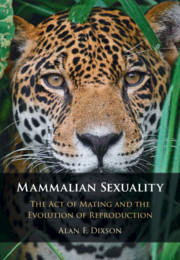Book contents
- Mammalian Sexuality
- Mammalian Sexuality
- Copyright page
- Dedication
- Contents
- Preface
- Acknowledgements
- Part I Carnival of the Animals
- Part II The Act of Mating
- Part III The Evolution of Reproduction
- 5 Phallic Structure and Function
- 6 The Testes and Spermatozoa
- 7 The Accessory Reproductive Glands and Ducts
- 8 Cooperation, Conflict and Cryptic Female Choice
- 9 The Evolution of Mating-induced and Spontaneous Ovulation
- Part IV Epilogue
- Book part
- References
- Index
6 - The Testes and Spermatozoa
from Part III - The Evolution of Reproduction
Published online by Cambridge University Press: 20 May 2021
- Mammalian Sexuality
- Mammalian Sexuality
- Copyright page
- Dedication
- Contents
- Preface
- Acknowledgements
- Part I Carnival of the Animals
- Part II The Act of Mating
- Part III The Evolution of Reproduction
- 5 Phallic Structure and Function
- 6 The Testes and Spermatozoa
- 7 The Accessory Reproductive Glands and Ducts
- 8 Cooperation, Conflict and Cryptic Female Choice
- 9 The Evolution of Mating-induced and Spontaneous Ovulation
- Part IV Epilogue
- Book part
- References
- Index
Summary
Evidence concerning occurrences of multiple-partner matings by female mammals was reviewed in Chapter 4. There, the conclusion reached was that sperm competition is widespread among extant members of the Monotremata, Marsupialia and Placentalia. Because sperm competition arises when the gametes of two or more males are situated in contention for access to a given set of ova, males that are able to produce and store larger numbers of sperm prior to mating may then gain a reproductive advantage via post-copulatory sexual selection. Greater sperm production may be achieved by increasing the mass of gamete-producing (seminiferous) tissue in the testes, or by increasing the rate of spermatogenesis. Evidence regarding both these mechanisms is discussed in this chapter. When sperm leave the testis, they pass via the excurrent ducts into the epididymis and are stored in its terminal region (cauda) prior to copulation. Transit times and numbers of sperm stored in the cauda are discussed here, as they may also be affected by post-copulatory sexual selection.
- Type
- Chapter
- Information
- Mammalian SexualityThe Act of Mating and the Evolution of Reproduction, pp. 155 - 186Publisher: Cambridge University PressPrint publication year: 2021

